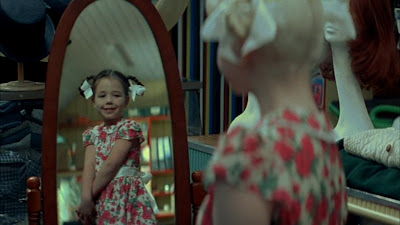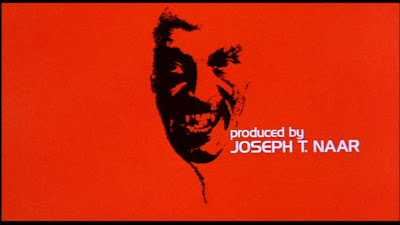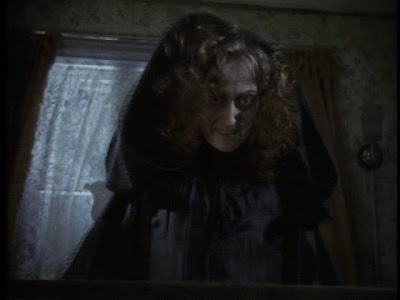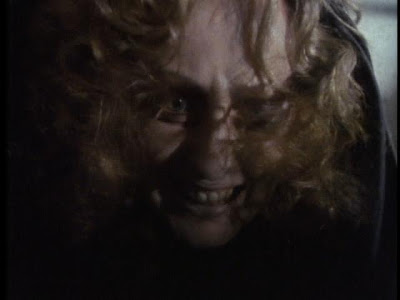
47 horror movies in 31 days. I'm pretty happy with that. They were all first time viewings and many were a great deal of fun. My list of need-to-see horror hasn't shrunk though - it's probably grown by close to double the amount I actually saw because of recommendations from others and new films that I found after doing some digging on the ones I saw.
Not really a bad problem to have is it? I've still got a bit of a stockpile at home of horror to watch, but now I'll be mixing in other fare too. I'll hopefully continue to write up the horror films, but will likely move them to the
Cesspool series of posts (and probably skip over the films that don't garner much of a reaction).
Eyes Of Laura Mars (1978 - Irvin Kershner) - A mix of 70s American grit and bright Italian horror, this is a great concept that occasionally works very well and sometimes falls flat. I love Faye Dunaway, but she's up and down here - her wide eyes are sometimes too incredulous looking and she overplays several scenes, but then she flashes a subtle smile and all is forgiven. Her new found ability to see the murders of her friends from the killer's point of view makes for several really well done sequences, but just never quite completely takes advantage of the idea. It's easy enough to guess early on that at some point she too will become a target of the killer (and see herself through his eyes), but they use that idea too early and again don't take full advantage of the concept. The fashion photography shoots are a hoot though.




 Dorothy Mills
Dorothy Mills (2009 - Agnes Merlet) - A surprisingly effective ghost story that takes place on a remote Irish island. A young girl is accused of assaulting her charge while she babysat and a psychiatrist from the city takes the case. Of course there are secrets a-plenty in the village and it occasionally gives off the vibe of
The Wicker Man, but there are further secrets within the village as well. The lovely Carice van Houten plays the doctor as sharp, perceptive, perhaps a bit too empathetic (she has her own reasons for wanting to save this girl which make her more susceptible to the ghostly presences) and very foreign to the islanders. It's beautifully shot and paced and leads to disturbing revelations. I hadn't even heard of this film previously to seeing it on the rental shelves, so I'm glad I took a chance on it.





 Drag Me To Hell
Drag Me To Hell (2009 - Sam Raimi) - OK, I could have done without some of the CGI effects and a few too many scenes of bodily fluids, but now I understand the praise thrown at Raimi's return to horror - it's a hell of a good time. Alison Lohman's young bank employee (aiming for the assistant manager's title) turns down an old hag's extension request on a loan and forecloses on her house. Suddenly she finds herself cursed and with 3 days left before her soul is taken to hell. In the mean time, she'll be haunted and terrorized by spirits unless she can figure out how to reverse the curse. Raimi throws gross moments, fake scares, sudden scares, slow building tension, high anxiety thrills and humour at the screen and most of it works. The CGI is more hit and miss - some of it meshes with the live action quite well and some of it sticks out like, well, bad CGI. Still, the film doesn't miss a beat and flies by in no time flat.






 The Howling
The Howling (1981 - Joe Dante) - I wrapped up my October viewings with a couple of werewolf features I've been meaning to get to for literally years. I'm not sure why I haven't as yet - there just always seemed to be something else I wanted to get to first and I vaguely remember some bad reviews at the time for both films. Fortunately, my first pick, Joe Dante's
The Howling, proved to be a fine take on the genre with an investigative TV reporter (Dee Wallace) getting involved with a serial killer, a psychologist and group therapy before finally learning how everything ties together. It has some early 80s issues - some bland performances, made-for-TV style lighting of some indoor scenes, etc. - but after a slow meandering build up from the TV studio to the group therapy commune, it begins to take its shape...Dante wisely holds back all the werewolf effects until deep into the movie at which point he begins to unleash them everywhere possible. And why not?






 Wolfen
Wolfen (1981 - Michael Wadleigh) - This odd entry into the werewolf genre is the only fictional feature film made by the director of
Woodstock. It's not exactly about werewolves though - it's about wolfen. They are wolf like creatures that have developed a high level of intelligence which enables them to track and hunt down their prey within the confines of a city. It's wrapped into a conservationist message and gets a bit too spiritual and preachy at times, but it does also manage to impress in spots such as the opening killings and numerous other setups in the film. It is longer than it needs to be at 2 hours, though, and tends to overuse its "wolfen-vision" a bit much.

















































































